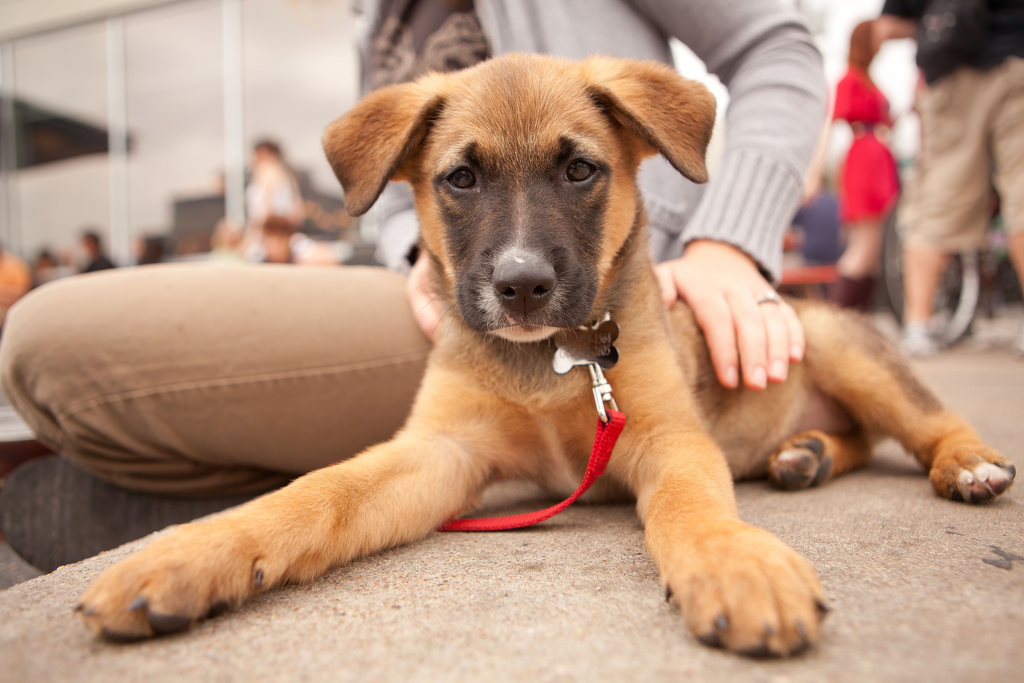
There are thousands of venues and events across the country that are designated “dog friendly,” from local pubs to music festivals. Here in Scotland, we're doubly lucky because we also have statutory access rights, giving everyone the right to roam across some of the world’s most beautiful landscapes, so taking your dog out and about is easy.
But before you decide to bring your dog along to a "dog friendly" festival or other event this summer, ask yourself: Would they really want to go? How will you be able to tell when they might not be enjoying themselves, and how can you make sure they have the best possible time? Read on for a few tips...

What does “dog friendly” really mean to a dog?
This will of course depend on the individual dog, their likes and dislikes and what particular things they enjoy (or prefer to avoid).
Take my own two dogs for example – Luke is highly sociable with people, but he can find it stressful being around lots of other dogs. He is also getting on in years and so doesn’t have the stamina for long days out. Mabel is sociable with people and dogs, but finds interacting with lots of them one after another quite stressful. Being deaf, she is hyper-sensitive to movement, and this can get tiring very quickly. She is also sensitive to vibrations: She can panic if a car passes by pounding loud music out of the window, or we encounter one of those awful things people add to their car exhaust to make it even noisier (apparently called a “cherry bomb” – right).
I have attended lots of dog friendly events in my time, and to the trained human eye, it can be a quite a distressing experience. Dogs are brilliant communicators, but most of their signs and signals are quite subtle and can easily go unnoticed, especially if their humans are busy having a good time.
Some signs that a dog might not be sharing in the fun include:
- Excessive panting
- Excessive salivating
- Tense body or face
- Inability to settle
- Freezing/staring
- Ears and/or tail held low
- Lip smacking
- Tongue flicks
- Turning the head away, facing away or trying to walk away
- Excessive or exaggerated yawning (dogs use this to communicate stress)
- Licking or jumping at people
- Whining/barking
- Shaking
- Hiding
- Refusal to take treats (especially if they would normally do so at home)
- Aggressive behaviours such as growling, snapping, biting
Any of these behaviours, especially for an extended period of time, or if there are several of them in succession, suggest a dog is actually having quite a bad time. Although many dogs will cope with being unhappy, is that really what we want when we take them out and about?
Is it your dog’s first event?
If your dog has no real experience of crowds, noise, or new environments, you will definitely want to introduce them gradually to each of the various aspects, ensuring you can manage things in a way that makes your dog feel safe and relaxed.
Introducing too many things all at once is enough to overwhelm, and can result in ongoing anxiety and behaviour problems.

Above: This dog is not showing any overtly friendly body language, and has limited behavioural options should she want to avoid being touched by the person reaching towards her. When meeting strangers, your dog should never be restrained, and should be encouraged to move away if they are not feeling sociable.
How to make sure you AND your dog have a good time
Before deciding to take your dog along to a “dog friendly” event, think carefully about what you will be asking your dog to put up with at that event, and for how long.
- Will there be crowds of people?
- Lots of noise?
- Will it be too hot or too cold?
- Will they have to travel?
- Will they miss, or have delayed meals?
- Will there be anywhere quiet for them to rest if it all gets too much?
Make a decision as to whether the event really will be something they will enjoy – if not, or if it is going to be a long day, your dog will likely be calmer and happier left at home or with someone who can spoil them with the things they do enjoy.
How to help your dog have a great time
If you decide to take your dog to a "dog friendly" event, the following tips should help ensure they have the best possible time:
- Pack a bag to ensure you have everything needed to keep your dog comfortable and happy: include plenty of water, something comfy to lie on, favourite toys and some special treats;
- At the event, monitor your dog regularly for signs of stress, and to see if they are trying to communicate that they would prefer to be elsewhere;
- Take regular time-outs: find somewhere secluded and quiet where your dog can rest (give them something soft to lie on if the floor is hard);
- Be your dog’s protector if necessary – don’t let people “force themselves” on your dog. Let your dog approach them and walk away when desired. This is key in preventing aggressive behaviour towards people (how else can your dog tell people to go away?);
- Do not be surprised if your dog shows different behaviours to those you might expect. S/he will be working hard to monitor and manage interactions with everyone in the vicinity, which can be exhausting even if they are having a good time. We all know that being tired makes us a bit less inhibited, or grouchy, sometimes.
Listen to your dog. Wherever you take them, you are responsible for their welfare. If you think they might be having a bad time, take them home.
Never tell your dog off or use punishment if you don’t like how your dog behaves. Make a note of what went wrong, and find ways to reward alternative behaviours in a less stressful setting. Punishing or shouting at your dog will make them more anxious and less trusting of you and other people.
Do I take my dogs to dog friendly venues and events?
Both my dogs are sociable and do work to assist me with behaviour cases, but I know their limits, and I know that for the vast majority of venues and events they would prefer a nice walk and then a kong and a chill at home rather than a noisy place where they would have to greet everyone in the room and then start again from the top (fun but tiring) as well as monitoring for the things they might find worrying (for Luke – other dogs, for Mabel – fast moving things).
Luke used to love coming to the pub but as an arthritic older man with a much greater requirement for rest he is now more comfortable snoozing at home, although the odd trip to a quiet pub with comfy places to sit is welcome (we love The Espy in Portobello!)
Do I wish I could bring my dogs to more events? Sometimes, but ultimately it isn’t about me, and by leaving them at home I can enjoy myself without worrying about them, knowing they are happy and safe and waiting for me to join them doing the things we love when I get home.
